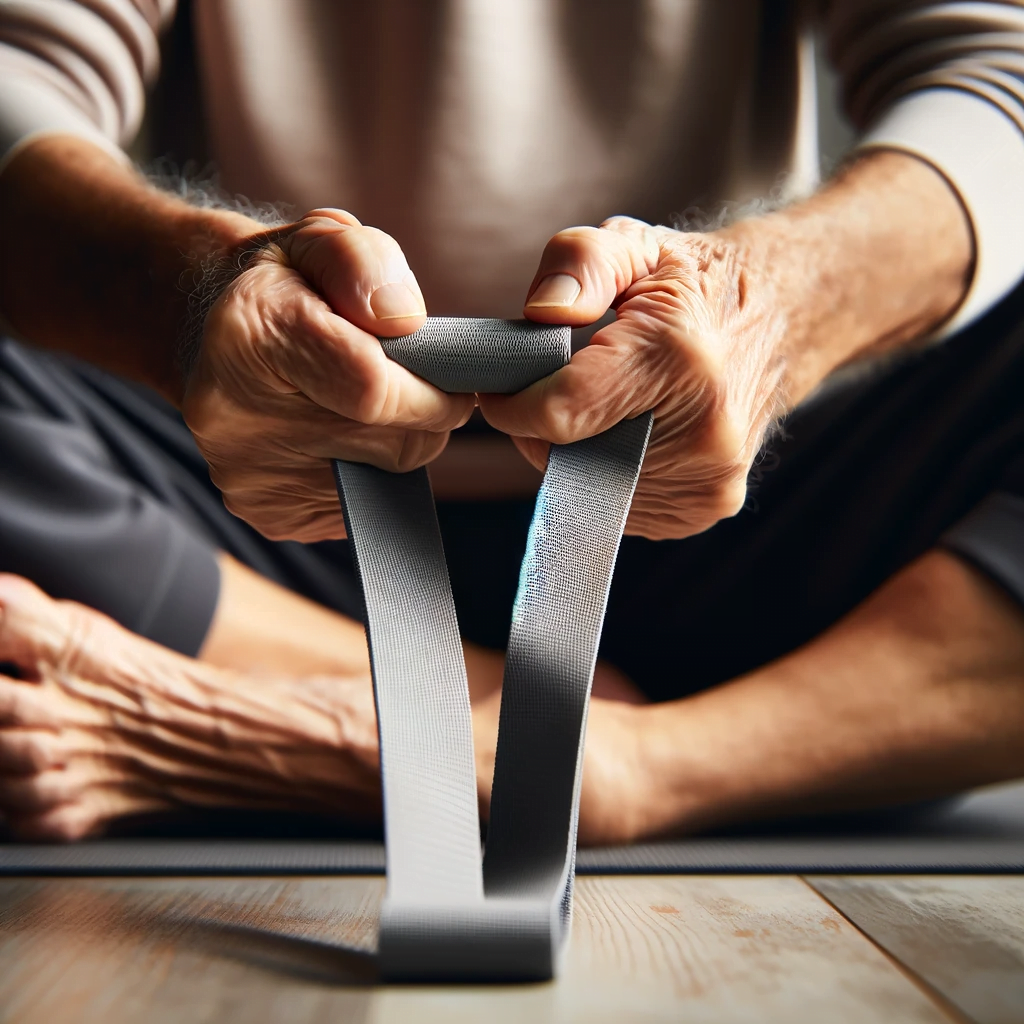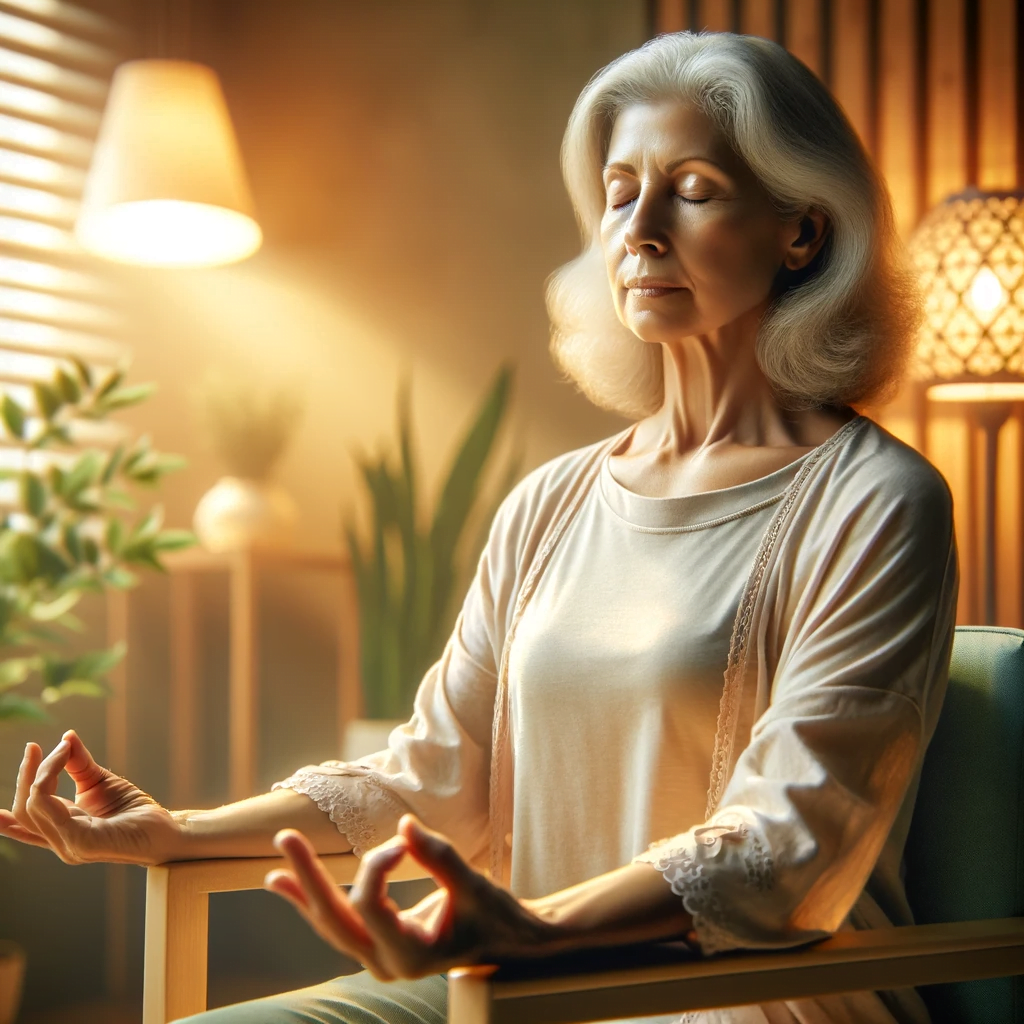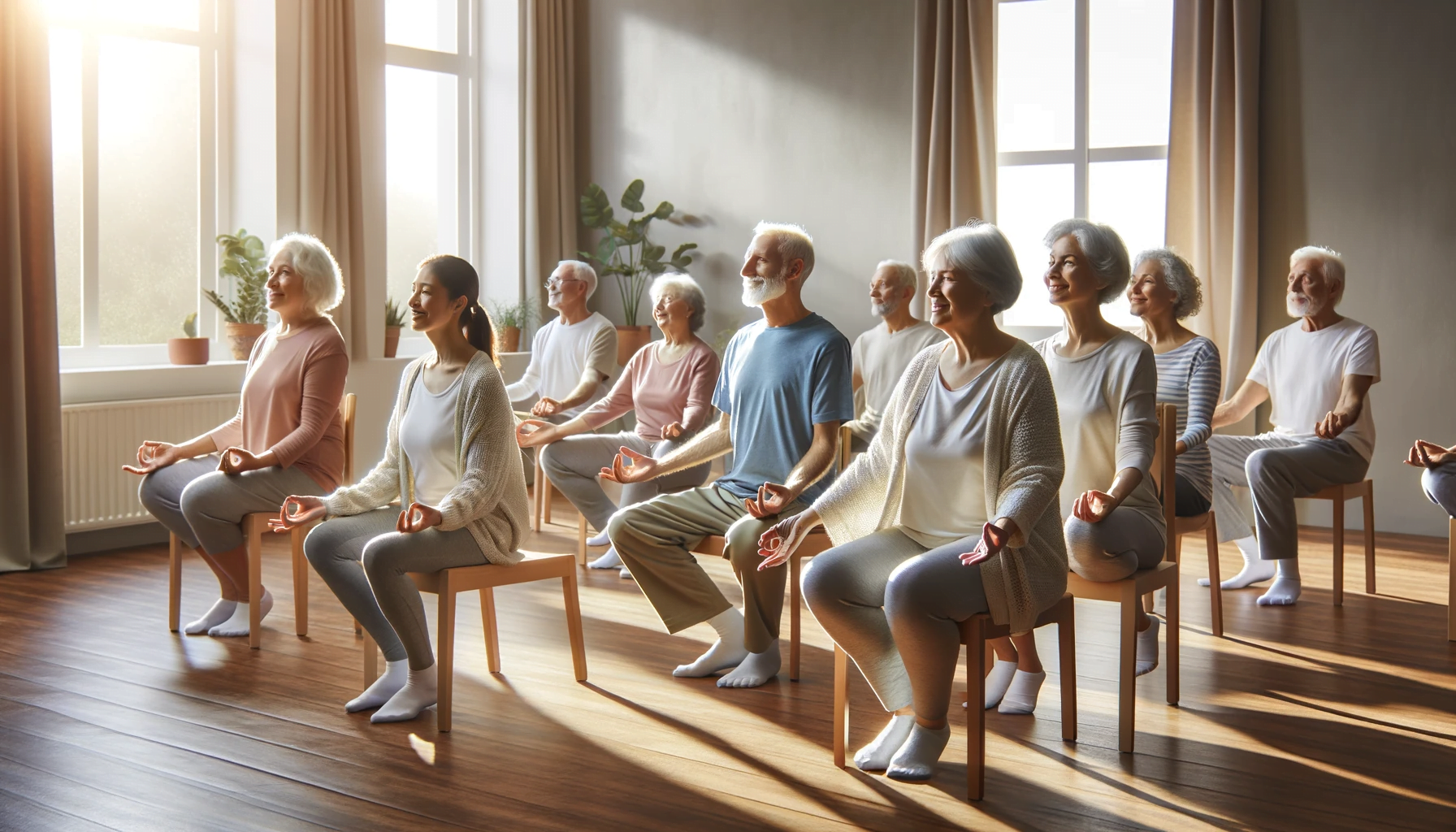Chair Yoga for Seniors – A Wonderful Workout in 2024!
Embracing the Power of Chair Yoga for Senior Wellness
Introduction to Chair Yoga for Seniors
In the journey of aging gracefully, maintaining physical and mental well-being is paramount. Chair yoga for seniors emerges as a beacon of hope, offering a gentle yet effective way to stay active, improve flexibility, and enhance overall health. This comprehensive guide delves into the world of chair yoga, exploring its benefits, techniques, and how it can be a transformative tool for seniors.
Understanding Chair Yoga for Seniors
What is Chair Yoga?
Chair yoga is a form of yoga that modifies traditional yoga poses for accessibility, allowing practitioners to perform exercises while seated or using a chair for support. It’s tailored to cater to those with mobility issues, balance concerns, or anyone who finds standing exercises challenging.
The Origin and Evolution
Tracing its roots back to the holistic principles of traditional yoga, chair yoga adapts ancient practices for modern needs. It emerged as a response to the growing demand for accessible fitness routines for the aging population and those with physical limitations.
The Benefits of Chair Yoga for Seniors
Enhanced Flexibility and Strength
Chair yoga helps seniors maintain muscle tone and flexibility, which are crucial for daily activities. The gentle stretching and strengthening exercises improve muscle elasticity, joint mobility, and overall physical resilience.
Improved Balance and Stability
With age, balance can become compromised, leading to a higher risk of falls. Chair yoga offers safe and effective ways to enhance stability and proprioception, reducing the likelihood of falls and related injuries.
Boosted Mental Health
Engaging in chair yoga also has profound mental health benefits. It can alleviate stress, anxiety, and depression, fostering a sense of peace and mental clarity. The meditative aspects of yoga promote mindfulness, enhancing emotional well-being.
Better Management of Chronic Conditions
Chair yoga can be particularly beneficial for managing chronic health conditions common in seniors, such as arthritis, hypertension, and diabetes. It aids in pain management, improves circulation, and helps regulate blood sugar levels.

Getting Started with Chair Yoga for Seniors
Choosing the Right Chair
When it comes to chair yoga, the importance of selecting the right chair cannot be overstated. Your chair serves as the foundation of your practice, offering support and stability as you engage in various poses. Here’s what to look for:
- Stability: A chair with a solid, sturdy construction is a must. It should comfortably support your weight without wobbling or shifting during movements.
- Design: Opt for a chair without arms to facilitate a wider range of motion. This design choice ensures that you can perform side stretches and twists without restriction.
- Height: The seat height should allow your feet to rest flat on the ground while your knees form a right angle. This position promotes proper alignment and balance.
- Comfort: Ensure the seat and backrest are comfortable for extended periods of sitting, especially if you have pre-existing back issues. Cushioning should support without sacrificing stability.
Creating a Safe Environment
The environment where you practice chair yoga contributes significantly to the safety and enjoyment of your session. To create an optimal space:
- Obstacle-Free Area: Clear the area around your chair of any objects that might pose a trip hazard. A clutter-free space allows for peace of mind and a focus on your practice.
- Lighting: Adequate lighting is crucial not only for safety but also for creating an inviting practice atmosphere. Natural light is ideal, but if that’s not available, ensure your space is well-lit with soft, ambient lighting.
- Floor Surface: A non-slip floor surface is essential to prevent the chair from sliding. If you’re on a slippery surface, place a yoga mat or a non-slip pad under the chair for added grip.
- Ventilation: Good air circulation is important, especially for those sessions that get your heart rate up. If possible, open a window or use a fan to keep the air moving.
Dressing Appropriately
What you wear during chair yoga can impact your flexibility, comfort, and overall experience. To get the most out of your practice:
- Flexible Clothing: Choose outfits that stretch and move with your body. This could mean yoga pants, leggings, or any comfortable, stretchy fabric that doesn’t restrict movement.
- Fit: While comfort is key, overly loose clothing can get in the way of poses or obscure your instructor’s view of your alignment. Aim for a happy medium—clothes that allow for movement without excess fabric.
- Footwear: Generally, chair yoga is practiced barefoot to enhance your sense of grounding and balance. However, if you prefer some form of footwear, choose non-slip socks or yoga shoes that offer grip without restricting foot movement.
By attentively selecting your chair, preparing your practice space, and dressing for success, you’re setting the stage for a fulfilling and safe chair yoga practice. These foundational steps not only enhance your experience but also ensure that you reap the full benefits of chair yoga, making it a truly wonderful workout for seniors in 2024.
Key Chair Yoga Poses for Seniors
Chair yoga for seniors is a gentle and effective way to maintain flexibility, strength, and wellness. As we move through 2024, it’s important to focus on key poses that offer the most benefits with minimal risk. These poses can be easily integrated into your daily routine, helping to improve posture, flexibility, and mental clarity.
Seated Mountain Pose (Tadasana)
The Seated Mountain Pose serves as a foundation for all other seated poses, emphasizing proper posture and body alignment. Here’s how to perform it:
- Positioning: Sit at the edge of your chair with your feet firmly planted on the ground, hip-width apart. Ensure your back is straight, and your shoulders are relaxed but upright.
- Execution: Place your hands on your thighs with palms down. Draw your shoulder blades towards each other and down your back, opening your chest.
- Focus: Engage your core muscles gently. Lengthen your spine as if a string is pulling you up from the crown of your head. Breathe deeply and evenly, feeling your connection to the earth through your sit bones and feet.
- Benefits: This pose helps in aligning the spine, strengthening the core, and improving posture. It’s also a great moment to cultivate mindfulness and a sense of grounding.
Chair Cat-Cow Stretch (Marjaryasana-Bitilasana)
The Chair Cat-Cow Stretch is an excellent way to bring flexibility and movement into the spine. It mimics the flow between two yoga poses, Cat and Cow, providing a gentle massage to the spine and belly organs.
- How to Do It: Sit comfortably with your feet flat on the floor. Place your hands on your knees. As you inhale, arch your back and look up, pushing your chest forward (Cow Pose). As you exhale, round your spine, pulling your belly in and dropping your head (Cat Pose).
- Repetition: Flow between these positions for several breaths, moving smoothly with each inhalation and exhalation.
- Benefits: This sequence helps to increase spine flexibility, relieve tension in the back and neck, and stimulate the digestive tract.
Seated Twist (Parivrtta Sukhasana)
The Seated Twist is a gentle way to increase spinal flexibility and stimulate digestion.
- Technique: Sit upright with your feet flat on the ground. Gently twist to the right, placing your left hand on the outside of your right thigh and your right hand on the chair back. Hold for a few breaths, then gently release and twist to the other side.
- Modifications: Ensure the twist initiates from your abdomen; keep the hips facing forward to avoid strain.
- Benefits: This pose aids in spinal flexibility, stimulates digestion, and helps to relieve tension in the back.
Leg Extension (Utthita Padangusthasana)
Strengthen your thighs and improve joint flexibility with the Leg Extension pose.
- Execution: Sit with your back straight and feet flat on the floor. Slowly extend your right leg forward, keeping your foot flexed and thigh muscles engaged. Hold for a moment, then slowly lower your leg. Repeat with the left leg.
- Considerations: Ensure your movements are slow and controlled. If needed, hold onto the sides of the chair for balance.
- Benefits: This pose strengthens the quadriceps, improves knee joint flexibility, and can help with balance.
Incorporating these chair yoga poses into your routine can significantly enhance your quality of life by improving physical flexibility, strength, and mental clarity. As always, listen to your body and make adjustments as necessary to accommodate your comfort and safety.
Incorporating Breath Work and Meditation
In the realm of chair yoga for seniors, the synthesis of breath work and meditation with physical movements forms a holistic approach to wellness. As we navigate through 2024, integrating these practices into our routines offers profound benefits for mind, body, and spirit. Let’s explore how to weave pranayama (breath work) and meditation into your chair yoga sessions, enhancing the overall experience and maximizing health benefits.
The Role of Pranayama in Chair Yoga
Pranayama, the art of breath control, is a cornerstone of yoga that significantly amplifies the benefits of your physical practice. In chair yoga, pranayama can be adapted to suit all ability levels, making it an inclusive practice for seniors seeking to improve their well-being. Here’s how pranayama enriches your chair yoga experience:
- Enhanced Lung Capacity: Regular pranayama practice increases lung efficiency, which is particularly beneficial for seniors. Enhanced breathing capacity supports better oxygenation of the body, vital for overall health and vitality.
- Elevated Energy Levels: By optimizing the breath, pranayama techniques help regulate the body’s energy flow. This can lead to increased alertness and vitality, reducing feelings of lethargy or fatigue.
- Stress Reduction: Pranayama has a calming effect on the nervous system, promoting relaxation and reducing stress. Techniques such as deep abdominal breathing, alternate nostril breathing, or even simple mindful breathing can help calm the mind and ease anxiety.
Incorporating pranayama into your chair yoga routine is simple. Begin with a few minutes of focused breathing at the start of your session. This sets a tranquil tone for the practice ahead and helps center your mind. Throughout the session, remain mindful of your breath, especially during transitions between poses.
Simple Meditation Techniques for Seniors
Meditation complements the physical aspects of chair yoga by fostering a deep sense of inner peace and clarity. For seniors, meditation can be an invaluable tool for enhancing mental health, improving concentration, and fostering a sense of connectedness. Here are some accessible ways to integrate meditation into your chair yoga practice:
- Breath-Focused Meditation: Start or end your chair yoga session with a few minutes of breath-focused meditation. Simply observe the natural flow of your breath, noticing the rise and fall of your abdomen. This practice helps quiet the mind and anchors you in the present moment.
- Guided Imagery: Engage in a short guided imagery exercise to conclude your session. Visualize a peaceful scene—perhaps a serene beach or a tranquil forest. This form of meditation can significantly enhance relaxation and reduce stress.
- Gratitude Meditation: Reflect on things you are grateful for, focusing on positive emotions. This can shift your mindset, reduce stress, and promote a greater sense of well-being.
By integrating pranayama and meditation into your chair yoga routine, you create a comprehensive wellness practice that supports not only physical health but also mental and emotional balance. These practices encourage a mindful approach to life, where breath and stillness become powerful tools for navigating the challenges of aging with grace and vitality.

Challenges to Chair Yoga for Seniors
While chair yoga is a fantastic way for seniors to maintain fitness, flexibility, and overall well-being, there can be hurdles along the way. Recognizing and addressing these challenges ensures a rewarding and sustainable practice.
Dealing with Limited Mobility
Limited mobility can pose a significant barrier to participating in any form of exercise, including chair yoga. However, with a few adjustments and the right tools, chair yoga can become an inclusive and beneficial activity for everyone.
- Adaptations: The beauty of chair yoga lies in its adaptability. Each pose can be modified to accommodate your body’s needs. For example, if fully extending your leg is difficult, consider a smaller range of motion until your flexibility improves.
- Props: Props are not just aids; they’re tools to deepen your practice. Yoga straps can help extend your reach, and blocks can bring the floor closer to you. Even a cushion or towel can be used to support various parts of the body for comfort and alignment.
- Professional Guidance: If you’re unsure about modifications, consider consulting a chair yoga instructor who is experienced in working with seniors. They can provide personalized adjustments to ensure a safe and effective practice.
Staying Motivated
Maintaining motivation is a common challenge, particularly when practicing alone. Here are strategies to keep your chair yoga journey exciting and rewarding:
- Routine: Establishing a regular practice time can help transform your chair yoga sessions into a habit. Consistency is key to feeling the cumulative benefits of yoga, such as improved flexibility, strength, and mental clarity.
- Community: Joining a group class, whether in-person or virtually, can significantly boost your motivation. The sense of community, shared experiences, and the opportunity for social interaction make the practice more enjoyable. Plus, you’ll have the chance to learn from others’ experiences and insights.
- Goals: Setting small, achievable goals can provide a sense of accomplishment and encourage progression. Whether it’s mastering a particular pose, improving your balance, or simply committing to practice a certain number of times per week, goals give you something to work towards.
- Variety: Integrating different poses, breathing exercises, or even incorporating meditation and mindfulness practices into your routine can keep your practice fresh and engaging. Don’t hesitate to explore new aspects of chair yoga to find what resonates with you.
By addressing the challenges of limited mobility and staying motivated with thoughtful solutions, seniors can fully embrace chair yoga as a rewarding, accessible form of exercise. Chair yoga is not just about maintaining physical health; it’s also about fostering a sense of community, achieving personal goals, and enhancing overall quality of life.
Conclusion to Chair Yoga for Seniors
Chair yoga for seniors is a gentle, adaptable form of exercise that offers numerous physical and mental health benefits. By incorporating it into their routine, seniors can enjoy improved flexibility, strength, balance, and mental clarity, contributing to a higher quality of life.
Further Resources and Classes
For those interested in exploring chair yoga further, local community centers, senior centers, and online platforms offer classes tailored to seniors. Books, DVDs, and online videos can also be valuable resources for home practice.
Embrace the transformative power of chair yoga and embark on a journey towards enhanced well-being and vitality in your senior years.

